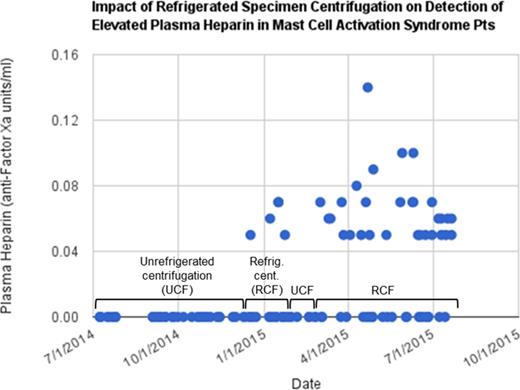Abstract
Distinct from mastocytosis and simple allergy and characterized by constitutive mast cell (MC) activation and aberrant MC reactivity with little to no excessive MC accumulation, MC activation syndrome (MCAS) presents as acute-on-chronic multisystem polymorbidity of generally inflammatory ± allergic theme; severity may be disabling. Given suspicion of epidemic prevalence of MCAS (Molderings GJ et al., PLoS One 2013;8(9):e76241), diagnostic testing efficiency is important. Diagnosis (Molderings GJ et al., J Hematol Oncol 2011;4:10) presently rests on identifying clinical presentation consistent with chronic/recurrent aberrant MC mediator release, identifying elevated MC mediator levels, and eliminating other relevant diagnostic considerations. MCs produce >200 mediators, but few can be tested in clinical laboratories; even fewer are relatively specific to the MC. Mediators often tested in MCAS work-ups include serum tryptase (sTryp) and chromogranin A (sCgA), plasma prostaglandin D2 (pPGD2) and histamine (pHist) and heparin (pHep), random (r) and 24-hour (24h) urinary PGD2 (uPGD2) and N-methylhistamine (uNMH) and leukotriene E4 (LTE4), and 24h urinary 11-β-PGF2α (u11βPGF2α). Testing the entire suite may be prohibitively expensive, but few data on frequency of elevation of MC mediators are available to guide cost-effective testing (pHep may be the most sensitive per Vysniauskaite M et al., PLoS ONE 2015;10(4):e0124912). Test accuracy for many MC mediators (especially heparin and the eicosanoids) is also challenged by thermolability and half-lives as short as ~1 minute. Loss of specimen chill during handling (e.g., unrefrigerated centrifugation (UCF)) or transport may yield false negatives.
Methods: We reviewed the charts of 198 adult pts (97% Caucasian, 84% female) evaluated at our center and diagnosed with MC activation disease (MCAD: MCAS (184), CM (4), indolent SM (9), aggressive SM (1)) from July 2014 through July 2015.
Results: Table 1 shows performance in MCAS pts of MC mediators in tests accessioned at our center (testing accessioned elsewhere censored to reduce bias from variability in specimen handling by pts and lab staff not known to have been educated regarding proper specimen handling). Our sTryp results agree closely with Vysniauskaite et al. but are lower than found in smaller cohorts in Zblewski D et al., Blood 2014;124(21):3204 (>33%) and Ravi A et al., J Allergy Clin Immunol Pract 2014;2(6):775.
MC mediator performance in diagnostic testing for MCAS.
| Mediator . | # Tests Performed . | # Tests Yielding Elevated Result . | % Elevated . | % Elevated Comparisons . | ||
|---|---|---|---|---|---|---|
| Vysniauskaite (n=238) . | Zblewski (n=15) . | Ravi (n=25) . | ||||
| sTryp | 147 | 13 | 8.8 | 10 | >40 | 40 |
| sCgA | 133 | 42 | 31.5 | 12 | ||
| pPGD2 | 113 | 15 | 13.2 | |||
| pHist | 133 | 39 | 29.3 | |||
| pHep* | 121 | 35 | 28.9 | 59 | ||
| r-uPGD2 | 102 | 10 | 9.8 | |||
| r-uNMH | 108 | 8 | 7.4 | |||
| r-uLTE4 | 68 | 3 | 4.4 | |||
| 24h-uPGD2 | 107 | 41 | 38.3 | |||
| 24h-uNMH | 111 | 6 | 5.4 | 22 | 8 | |
| 24h-uLTE4 | 72 | 6 | 8.3 | |||
| 24h-u11βPGF2α | 68 | 25 | 36.8 | |||
| Mediator . | # Tests Performed . | # Tests Yielding Elevated Result . | % Elevated . | % Elevated Comparisons . | ||
|---|---|---|---|---|---|---|
| Vysniauskaite (n=238) . | Zblewski (n=15) . | Ravi (n=25) . | ||||
| sTryp | 147 | 13 | 8.8 | 10 | >40 | 40 |
| sCgA | 133 | 42 | 31.5 | 12 | ||
| pPGD2 | 113 | 15 | 13.2 | |||
| pHist | 133 | 39 | 29.3 | |||
| pHep* | 121 | 35 | 28.9 | 59 | ||
| r-uPGD2 | 102 | 10 | 9.8 | |||
| r-uNMH | 108 | 8 | 7.4 | |||
| r-uLTE4 | 68 | 3 | 4.4 | |||
| 24h-uPGD2 | 107 | 41 | 38.3 | |||
| 24h-uNMH | 111 | 6 | 5.4 | 22 | 8 | |
| 24h-uLTE4 | 72 | 6 | 8.3 | |||
| 24h-u11βPGF2α | 68 | 25 | 36.8 | |||
*Results affected by use of UCF in some cases; see below.
Upon our recognition of oddly persistently negative pHep levels, a review of procedures in late December 2014 discovered specimen centrifugation since July 2014 had not been refrigerated. Refrigerated centrifugation (RCF) was immediately instituted, but lab issues led to inadvertent return in February 2015 to UCF which was re-discovered and re-corrected in March 2015. The rate of finding elevations in pHep levels (upper normal 0.02 anti-Factor Xa units/ml per Seidel et al., Thromb Haemost 2011;106(5):987) appeared strongly correlated with use of RCF (p <0.00001; Figure 1). RCF improved the rate of finding elevated pHep from 1 of 50 patients tested (2.0%) to 34 of 70 patients tested (48.6%). Other mediators did not appear significantly affected by UCF.
Conclusions: In our cohort (5:1 female:male vs. previously reported 2-3:1 ratios), pHep, 24uPGD2, and 24u11βPG2α appeared the most sensitive indicators of MC activation; sTryp and urinary NMH and LTE4 appeared least sensitive. Our data confirm others' findings that sTryp is seldom elevated in MCAS; thus, normal sTryp decreases likelihood of mastocytosis but not MCAS. A sensitive assay is needed when testing pHep for evidence of MC activation as most elevated pHep levels in the MCAS population are below more commonly used assays' lower limits of detection (typically 0.10-0.20 anti-Factor Xa units/ml, geared to detect therapeutic pHep levels). Continuous specimen chilling appears important in accurately measuring pHep.
No relevant conflicts of interest to declare.
Author notes
Asterisk with author names denotes non-ASH members.


